Kenneth C. Davis's Blog, page 76
July 13, 2015
Who Said It? (7/13/15)
President Harry S. Truman (July 17, 1945) “Notes on the Potsdam Conference” (July 17-30, 1945)
“I can deal with Stalin. He is honest–but smart as hell.”

President Harry S. Truman
(Photo: Truman Library)
Source: Harry S. Truman Library and Museum Decision to Drop the Atomic Bomb Documents
The Potsdam Conference was a meeting of Truman, Churchill and Stalin that took place near Berlin after the defeat of Germany in May 1945. It was during this conference among the World War II allies that Truman learned of the successful test of the atomic bomb in New Mexico on July 16, 1945. The leader of the Manhattan Project, General Leslie Groves, wrote an extensive description of the “Trinity” test which was sent to Truman
He would soon decide to use the bomb against Japan and inform Soviet leader Stalin of its existence. Stalin already knew about the atomic bomb and the Soviets were racing to compete their own atomic weapon. The Cold War atomic arms race was underway, and is detailed in THE HIDDEN HISTORY OF AMERICA AT WAR.

The Hidden History of America At War (Hachette Books Random House Audio)
July 4, 2015
Whatever Became of 56 Signers? (11 of 11)
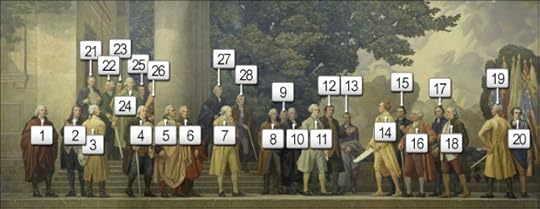
The Declaration Mural by Barry Faukner (National Archives)
Last part of a series on the lives of the 56 men who signed the Declaration of Independence, adopted by the Second Continental Congress on July 4, 1776. (A YES following the entry means the signer owned slaves; a NO means he did not own slaves.)
…We mutually pledge to each other our Lives, our Fortunes , and our Sacred Honor.
A New England slaver. A forgotten founder who died in debt and disgrace. A college president. A legendary bullet maker. Jefferson’s teacher –and a murder victim. Last but not least among the 56 signers.
-William Whipple (New Hampshire) Usually described as a 46 year old merchant, he was more precisely a sea captain who made a fortune sailing between Africa and the West Indies — in other words, the slave trade. He also owned slaves and one of those people, known as Prince, accompanied Whipple throughout his illustrious career as an officer in the Revolution. It was thought that Prince was the black man depicted in the famous “Washington Crossing the Delaware” painting, but that is not accurate because Prince and Whipple were far from the action that night. Whipple later served in a variety of state offices in New Hampshire and legally manumitted Prince –who also went by the name of Caleb Quotum — in 1784. Whipple died in Portsmouth in 1785. YES
-William Williams (Connecticut) A 45 year old merchant, he was a veteran of the French and Indian War who had married the daughter of Connecticut’s Royal Governor. He was not present for the July vote but signed the Declaration and was a tireless supporter of the war effort. After a long career in public service, he died in 1811, aged 71. NO
-James Wilson (Pennsylvania) Scottish born, he was a 33 year old lawyer at the time of the signing and one of the most important Founding Fathers you probably never heard of. A key supporter of the Declaration, he was among the signers and Philadelphia elites who were attacked in Wilson’s home during the war in a riot over food prices and scarcity. He was also a key member of the Constitutional Convention, credited with several significant compromises. Although hopeful to be made Chief Justice of the new Supreme Court, he was appointed an associate by Washington. But land speculation ruined him and he ended up in debtor’s prison, like his colleague Robert (corrected from earlier version) Morris (See previous post #7) before his death in disgrace at age 55 in 1798, an embarrassment to his Federalists friends and colleagues. NO
-John Witherspoon (New Jersey) Another profoundly influential immigrant, the Scottish born minister was 53 year old president of the College of New Jersey (later Princeton) where his hatred of the British influenced many students including notable schoolmates Aaron Burr and James Madison. He lost a son at the battle of Germantown in 1777 but continued his career in Congress. After the war, he attempted to rebuild the college and was a prime mover in the growth and organization of the Presbyterian Church. He died in 1794 in Princeton, where the is buried, at age 71. YES
-Oliver Wolcott (Connecticut) A 49 year old lawyer, he was a veteran of the French and Indian War who was not present for the vote and signed at a later date. Wolcott was in New York when Washington’s troops tore down a statue of King George III after hearing the Declaration of Independence read. He is credited with the plan to melt down the lead statue and turn it into bullets for the war effort. He served in the Connecticut militia during the Revolution and held a series of state posts after the war including as governor of Connecticut at his death in 1797 , aged 71. YES
-George Wythe (Virginia) A 50 year old lawyer, he made his greatest mark as a teacher of law to Thomas Jefferson at the College of William and Mary –as well as later students including James Monroe, future Chief Justice John Marshall and congressman Henry Clay, earning him the title “America’s first law professor.” He died in 1806 , around 80, apparently murdered by a nephew who was perturbed that Wythe was planning to free the slaves that the young man was supposed to inherit. (The nephew was acquitted of murder but convicted of forging his uncle’s checks). YES
Read the story of James Wilson and the Philadelphia Riot in America’s Hidden History.
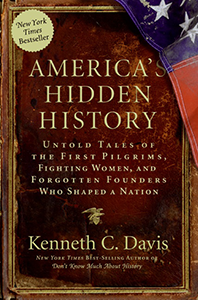
America’s Hidden History, includes tales of “Forgotten Founders”

Don’t Know Much About® History: Anniversary Edition (Harper Perennial and Random House Audio)

The Hidden History of America At War-May 5, 2015 (Hachette Books/Random House Audio)
July 3, 2015
Whatever Became of 56 Signers (Part 10 of 11)
(Part 10 of a series that begins here. A YES at the end of the entry means the signer owned slaves; NO means he did not.)
…We mutually pledge to each other our Lives, our Fortunes , and our Sacred Honor.
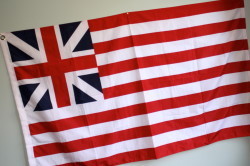
The Grand Flag of the Union, first raised in 1775 and by George Washington in early 1776 in Boston. The Stars and Stripes did not become the “American flag” until June 14, 1777. (Author photo © Kenneth C. Davis)
A victim of the British. Two Irish immigrants. An orphaned carpenter. Among the next five of 56 signers.
-Richard Stockton (New Jersey) Of the signers who clearly suffered for his actions, this successful and widely-admired 45 year old attorney at the signing, may have suffered most. Stockton is also credited with recruiting John Witherspoon, an influential Sottish minister, (See next installment in series) to become president of the College of New Jersey (later Princeton). Betrayed by loyalists in his home state, he was captured by the British in 1776, although later released in a prisoner exchange, not for having sworn allegiance to the King, as reported in a much-disputed rumor of the day. His New Jersey home was also damaged by the British but later restored. Stockton was in poor health after the experience in captivity but lived until 1781, when he died of throat cancer. YES
-Thomas Stone (Maryland) Among the conservatives in Congress, he was a 33 year old attorney at the signing, reluctant about independence, but then joining in the favorable vote. Another son of a wealthy planter, he had a low profile after the signing, helping write the Articles of Confederation but not signing them. He also declined to take part in the Constitutional Convention, when his wife, who fell ill following an inoculation against smallpox, died in 1787. Apparently despondent, he died four months later in 1787 at age 44. YES
-George Taylor (Pennsylvania) Arriving in America as an indentured servant from Ireland, he was a 60 year old merchant and iron maker at the signing. He had risen at the foundry where he worked to become bookkeeper, then bought the business after his employer’s death and then married the late owner’s widow. Taylor was not in the influential Pennsylvania delegation for the July vote, but signed the document in August. During the war, his foundry provided cannon and cannonballs for the war effort, but Congress was notoriously slow to pay its bills and his business suffered. He died in 1781 at age 65. YES
-Matthew Thornton (New Hampshire) An Irish-born physician, he was around 62 at the signing, a veteran surgeon who had served with the New Hampshire militia in the French and Indian War. A latecomer to Congress, he joined in November 1776 and was later permitted to add his name to the document. He later served as a state judge and then operated a farm and ferry before his death in 1803 at about age 89. NO
-George Walton (Georgia) Orphaned and apprenticed as a carpenter, he was a 35 year old self taught attorney at the signing. Serving with the Georgia militia, he was shot and captured by the British in 1778. Well-treated, he was held for a year before being exchanged for a British officer –even though it was known he was a signer. He later served in a variety of state offices, including governor and senator from Georgia, and built a home on lands confiscated after the war from a Tory, or Loyalist. He is implicated in the events that led to the duel that killed fellow signer and political rival Button Gwinnet (see Part 3 of series). He died in 1804, aged 63. NO? Unable to confirm pending further investigation.

Don’t Know Much About® the American Presidents (Hyperion Paperback-April 15, 2014)

Don’t Know Much About® History: Anniversary Edition (Harper Perennial and Random House Audio)
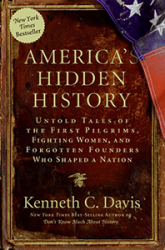
America’s Hidden History, includes tales of “Forgotten Founders”
July 2, 2015
Whatever Became of 56 Signers? (Part 9)
(Part 9 in a series that begins here; a YES following the entry means the signer owned slaves; NO means he did not own slaves.)
…We mutually pledge to each other our Lives, our Fortunes , and our Sacred Honor.

The Grand Flag of the Union, first raised in 1775 and by George Washington in early 1776 in Boston. The Stars and Stripes did not become the “American flag” until June 14, 1777. (Author photo © Kenneth C. Davis)
Betsy Ross’s uncle. The “first psychiatrist.” Youngest signer. The Great Compromiser. An Irish man named Smith. The next five signers:
-George Ross (Pennsylvania) The son of a Scottish-born minister, he was a 46 year old attorney at the signing, a loyalist before turning to the patriot cause in 1775. Yes, he was Betsy’s uncle, but the rest of the Ross flag story has been dismissed as family legend. He left Congress in early 1777 due to illness — the same severe gout that afflicted a number of signers– and served as a Pennsylvania judge before his death in 1779 at 49, following a severe attack of gout. NO
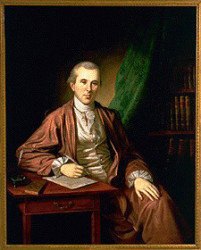
Dr Benjamin Rush by Charles Willson Peale c. 1783. Winterthur Museum
-Benjamin Rush (Pennsylvania) Raised by a widowed mother, he was a 30 year old physician at the signing, youngest in the Pennsylvania delegation. He was elected after the July vote and his diaries, letters and notes provided some of the best portraits of many of the signers and other founders. He served as surgeon general of the armies during the war, and became an early abolitionist while still owning a slave himself. Rush was an early advocate of many modern medical practices, while at the same time practicing bloodletting. He established the first free medical clinic and remained in Philadelphia during a yellow fever epidemic, spoke against capital punishment and for the idea that there was mental illness which led to his being called “The Father of American Psychiatry.” He died of typhus in 1813 at age 67. YES
-Edward Rutledge (South Carolina) Son of an Irish immigrant physician, he was a 26 year old attorney at the signing, the youngest of the signers. Rutledge later left Congress and was captured by the British when Charleston fell in May 1780 and was held for nearly a year. After the war, his finances and businesses flourished and he returned to state politics, and was elected governor of South Carolina, but died at 50 in 1800, before his term ended. YES
-Roger Sherman (Connecticut) A self-educated son of a farmer, he was a prosperous merchant, attorney and politician, aged 55 at the signing. He would sign three of the central documents in America’s foundation: the Declaration (he was a member of the draft committee), the Articles of Confederation, and the U.S. Constitution. It was at the 1787 convention that Sherman proposed the “Great Compromise” that ended the deadlock between large and small states. He was also a true “Founding Father”–after Carroll (18 children) and Ellery (16 children), Sherman fathered the third most children among the signers -15. A leading Federalist, he served in the House and Senate, where he was serving at his death in 1793 at age 72. NO
-James Smith (Pennsylvania) Another immigrant signer, he was born in Ireland and was around 57 at the signing, another self-taught attorney. Elected to Congress after the July vote, he signed the Declaration. He returned to law practice and state offices before his death in 1806 at about age 87. NO

The Hidden History of America At War-May 5, 2015 (Hachette Books/Random House Audio)

Don’t Know Much About® History: Anniversary Edition (Harper Perennial and Random House Audio)

America’s Hidden History, includes tales of “Forgotten Founders”
July 1, 2015
Whatever Became of 56 Signers? (Part 8)
[Part 8 of a series that begins here; Note: YES following an entry means the signer owned slaves; NO means he didi not.]
…We mutually pledge to each other our Lives, our Fortunes , and our Sacred Honor.

The Grand Flag of the Union, first raised in 1775 and by George Washington in early 1776 in Boston. The Stars and Stripes did not become the “American flag” until June 14, 1777. (Author photo © Kenneth C. Davis)
Minister turned lawyer. Self-taught planters’s sons. A Nay vote. A rare bachelor. And a veiled man. The next six signers:
-Thomas Nelson, Jr. (Virginia) Another son of a wealthy planter. he was a 37 year old merchant-planter at the signing, owner of more than 400 enslaved people. He raised money to supply troops and even commanded militia. Legend has it that he fired a cannon at his own Yorktown mansion during the 1781 siege when told that it was British headquarters. The war cost him financially and he was in ill health, retiring as Virginia’s governor and living on his plantation until his death at 50 in 1789. YES
-William Paca (Maryland) An attorney and wealthy planter’s son, he was 35 at the signing. A patriot leader in somewhat conservative Maryland, he helped bring the state to favor independence at Philadelphia. He raised funds for the war effort and later, as Congressman, worked to support veterans. An advocate of the Constitution, he was later appointed a federal judge by President Washington, and was in that post at his death in 1799 at age 58. YES
-Robert Treat Paine (Massachusetts) Overshadowed by two Adamses and Hancock from Massachusetts, he was a minister turned attorney, 45 at the signing, best known as one of the prosecutors in the 1770 trial of the British soldiers charged in “Boston Massacre.” His friend and fellow delegate John Adams had served rather successfully as their defender. In 1780, he was among the founders of the American Academy of Arts and Sciences, one of the first American groups dedicated to expanding scientific knowledge and learning. After the war, he remained active in Massachusetts politics and was named a state judge by Hancock until his retirement in 1804 due to deafness. He died in 1814 at age 83. NO
-John Penn (North Carolina) A wealthy planter’s son who taught himself to read and write, he was a 36 year old attorney at the signing. He remained in Congress and was one of the signers who also signed the first American constitution, the Articles of Confederation. He retired to private law practice and died in 1788 at age 48. YES
-George Read ( Delaware) Among the conservative delegates, he was a 42 year old lawyer at the time of the signing but had voted against independence on July 2.He served in state offices until ill health forced his resignation. But he returned to Philadelphia to take part in the Constitutional convention and was leading voice for small states’s rights and led the ratification forces in Delaware, the first state to ratify the Constitution. Elected to the Senate, he resigned to take a judgeship in Delaware before his death in 1798 at age 65. YES
-Caesar Rodney (Delaware) Another self educated attorney, son of a planter, he was 47 at the signing. He is best known for an 80 mile ride in a storm to break a deadlock that put Delaware in the independence column –which cost him favor with conservatives in his home state. One of the three bachelor signers (Francis Lee and Thomas Lynch were the others), he remained in the Congress until he became Delaware’s state president. A cancerous growth on his face was untreated and he covered it with a silk veil, worn for a decade before his death in 1784 at age 55. YES

Don’t Know Much About® the American Presidents (Hyperion Paperback-April 15, 2014)

Don’t Know Much About® History: Anniversary Edition (Harper Perennial and Random House Audio)
June 30, 2015
Who Said It? (6/30/2015)

Frederick Douglass by Samuel J,. Miller (1847-1852)
This Fourth [of] July is yours, not mine. You may rejoice, I must mourn.
Frederick Douglass, “What to the Slave is the Fourth of July?” (July 5, 1852)
I am not included within the pale of this glorious anniversary! Your high independence only reveals the immeasurable distance between us. The blessings in which you, this day, rejoice, are not enjoyed in common. — The rich inheritance of justice, liberty, prosperity and independence, bequeathed by your fathers, is shared by you, not by me. The sunlight that brought life and healing to you, has brought stripes and death to me. This Fourth [of] July is yours, not mine. You may rejoice, I must mourn. To drag a man in fetters into the grand illuminated temple of liberty, and call upon him to join you in joyous anthems, were inhuman mockery and sacrilegious irony. Do you mean, citizens, to mock me, by asking me to speak to-day?
Source and Full Text: Africans in America -PBS
On July 5, 1852, Douglass gave a speech at an event commemorating the signing of the Declaration of Independence, held at Rochester’s Corinthian Hall.
Read more in Don’t Know Much About History and Don’t Know Much About the Civil War
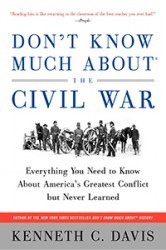
Don’t Know Much About the Civil War (Harper paperback, Random House Audio)

Don’t Know Much About® History: Anniversary Edition (Harper Perennial and Random House Audio)
Whatever Became of 56 Signers (7th in series)
(Part 7 in a series that begins here.)
…We mutually pledge to each other our Lives, our Fortunes , and our Sacred Honor.

The Grand Flag of the Union, first raised in 1775 and by George Washington in early 1776 in Boston. The Stars and Stripes did not become the “American flag” until June 14, 1777. (Author photo © Kenneth C. Davis)
A tavern owner’s son. Two of America’s wealthiest men –both named Morris. And the first to die. The next five signers in this series;
-Thomas McKean (Delaware) Son of a Pennsylvania farmer-tavern owner, McKean was a self educated, 42 year old attorney turned politician at the time of the signing (although he did not sign in 1776). A vigorous patriot, he held offices in both his native Pennsylvania and Delaware and was a key supporter of the Declaration. When another delegate from Delaware was absent and the state might vote against independence, McKean sent a horse and rider to collect fellow delegate Caesar Rodney and bring him back to vote —an 80 mile ride in a storm. There is some dispute about when he actually signed but is was after January 1777. McKean and his family were pursued by the British but never captured. A vocal advocate of the Constitution, he served in many state posts, including governor of Pennsylvania, and prospered after the war. He died in 1817 at age 83. YES
-Arthur Middleton (South Carolina) A 34 year old plantation owner, at the signing, replaced his father –thought too conservative — in Congress. Educated in England he became active in patriot politics.One of the few deletes to serve in the wartime militia, he was captured in Charleston in 1780, along with Thomas Heyward (See post #4) and Rutledge, two other South Carolina signers. Although his home had been destroyed he was released by the British and returned to Congress in 1781. After the war he returned to his plantation where he died at age 44 in 1787. YES
-Lewis Morris (New York) Another of the wealthy sons of prominent New York families in the state’s delegation, Morris was a 50 year old land owner with large holdings in what is now the Bronx in New York City. Although his home was attacked during the war, it was attacked and severely damaged because of its value, not because he was a signer. Morris led troops of the militia during the vote in July but then led the New York delegation in later signing the Declaration, making it unanimous. Morris rebuilt the family home and land holdings after the war and was a leader with Alexander Hamilton in ratification of the Constitution. He died in 1798, aged 71 and his former plantation is known today as the Morrisania section of the Bronx. YES
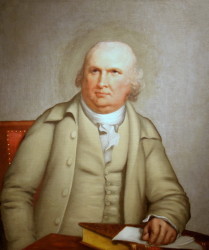
Oil painting of Robert Morris by Robert Pine (c. 1785)
-Robert Morris (Pennsylvania) (No relation to Lewis Morris above.) One of the wealthiest individuals in America, he was a 42 year old Philadelphia merchant and speculator when he signed. Born in Liverpool, he had come to America and made a fortune as a merchant, becoming the “Financier of the Revolution.” Accused of profiteering during the war, he was attacked in the Philadelphia home of fellow signer James Wilson. A delegate to the Constitutional Convention in 1787, he declined to serve as Washington’s secretary of Treasury, recommending Alexander Hamilton instead. He later became a Senator. But he lost his fortune through land speculation and was bankrupted and put in debtor’s prison. He died in poverty and relative obscurity in 1806, aged 72. YES
-John Morton (Pennsylvania) A farm boy turned surveyor, he was 52 at the time of the signing. He has two key distinctions: his vote pushed Pennsylvania into the pro-independence camp and then he was first signer to die. He fell ill in 1777 and died at about age 52, leaving his farm and slaves to his wife and children who had to flee from a British attack. YES

Don’t Know Much About® the American Presidents (Hyperion Paperback-April 15, 2014)

Don’t Know Much About® History: Anniversary Edition (Harper Perennial and Random House Audio)

America’s Hidden History, includes tales of “Forgotten Founders”
June 29, 2015
Whatever Became of 56 Signers? (6th in a series)
…We mutually pledge to each other our Lives, our Fortunes , and our Sacred Honor.

The Grand Flag of the Union, first raised in 1775 and by George Washington in early 1776 in Boston. The Stars and Stripes did not become the “American flag” until June 14, 1777. (Author photo © Kenneth C. Davis)
(Sixth in a series. The first post is here.)
-Richard Henry Lee (Virginia) A 41 year old planter from a prominent Virginia family –his younger brother Francis Lightfoot (previous post) was also there– Lee deserves more acclaim than he usually gets. A “great orator,” said John Adams, Lee introduced the resolution for independence. Curiously he left Congress and didn’t vote for it or the Declaration, which he signed later in the summer of 1776. He was one of the few signers to actually serve with a Virginia militia unit. He remained in poetics after the war, becoming a vocal opponent of the Constitution but an advocate for the Bill of Rights. He was elected to the U.S. Senate but resigned in ill health and died at age 62 in 1794.
-Francis Lewis (New York) A native of Wales, he was a 63 year old merchant at the time of the signing, a key supporter of George Washington, but was instructed not to vote for the Declaration by New York. He then signed in August. During the war, his wife was imprisoned by the British and died shortly after her release, leaving Lewis grief-stricken. He died in 1802 at age 89, was buried in an unmarked grave at Manhattan’s Trinity Church, and now, curious New Yorkers will know why there is a Francis Lewis Boulevard in Queens.
-Philip Livingston (New York) The 60-year-old member of one of New York’s wealthiest families, he was a merchant who favored the patriot cause but was, like many New Yorkers, more moderate about declaring independence and was absent when the entire delegation abstained from the vote. But he signed in August. (Robert Livingston, a cousin and member of the Declaration draft committee, was also absent from the vote and never signed the Declaration). The British occupied his Brooklyn home after the fall of New York and used it as a hospital. Although he sold some of his property to support the war effort, his family continued to amass large land holdings in upstate New York. In poor health, he died at age 62 in 1778, when Congress was forced to evacuate Philadelphia and moved to York, Pa.
-Thomas Lynch, Jr. (South Carolina) At 27, the second youngest signer (after Edward Rutledge also of South Carolina), he was lawyer and son of a delegate. When his father, a wealthy planter, suffered a stroke, the younger Lynch was sent to Congress. (His father was unable to vote or sign.) Both left for home in poor health and the elder Lynch died en route. Lynch Jr. and his wife later sailed for France in the hope of regaining his health but both died at sea in 1779.

Don’t Know Much About® History: Anniversary Edition (Harper Perennial and Random House Audio)

Don’t Know Much About® the American Presidents (Hyperion Paperback-April 15, 2014)

America’s Hidden History, includes tales of “Forgotten Founders”
June 28, 2015
Whatever Became of 56 Signers (5th in a series)

Fair Copy of the Draft of the Declaration of Independence (Source New York Public Library)
Early abolitionist. Flag designer. “First President.” And the Author.
-Stephen Hopkins (Rhode Island) Second oldest delegate after Franklin, Hopkins was 69 years old at the signing. A merchant, he had been Rhode Island’s colonial governor but was an outspoken advocate of independence. A partner of the wealthy Brown brothers who were involved in the slave trade –Newport was a key northern slavery port– he owned several enslaved people. But in 1774, he secured passage of law prohibiting the slave trade in Rhode Island, one of the first anti-slavery laws in the colonies and he began freeing some but not all of his personal slaves. In ill health, he retired from politics and public life and died in 1785 at age 78.
-Francis Hopkinson (New Jersey) Like Franklin and Jefferson, Hopkinson was a man of many talents, a 38 year old attorney and musician at the time of the signing, he was the son of the founder –with Franklin of the University of Pennsylvania– and was among the school’s first graduates. Though long overlooked, he has more recently gotten his due as the designer of the “Stars and Stripes.” The claim is based on Hopkinson submitting a bill for his work on the flag and requesting “a quarter cask of the public wine” in payment. He was already on the Congressional payroll so was refused. While his home was ransacked during the war, he emerged relatively unscathed and later became a Federal judge before his death in 1791 at 53.
-Samuel Huntington (Connecticut) An apprenticed barrel-maker who became a successful attorney, he was a 45 year old politician at the time of the signing, having resigned his post as “King’s Attorney.” His true distinction is serving as “President of the United States in Congress Assembled” when the Articles of Confederation were adopted –making him the “First President,” sort of. Others have staked that claim as well. He served in a variety of national and state posts, including being the sitting governor of Connecticut at his death in 1796 at age 64.
-Thomas Jefferson (Virginia) 33 year old planter, scientist, writer, lawyer. You know most of the rest. But Jefferson’s wartime service as Virginia’s governor is sometimes overlooked. In 1781,he was governor when the British attacked the state, including forces led by Benedict Arnold. Jefferson fled and was later investigated by the state legislature but no charges were filed. Some of his slaves were taken by the British and were being held in Yorktown during the siege in September-October 1781 and were later returned to Jefferson by George Washington. He died, like John Adams, on the 50th anniversary of the adoption–July 4, 1826. See the Monticello site for more information.
-Francis Lightfoot Lee (Virginia) A member of the state’s prominent planter family, he was 41 years old at the signing, the quiet brother of Richard Henry Lee, who offered the first resolution calling for independence in June 1776. After the war, he was a prominent advocate of the new Constitution, unlike his more visible older brother. He left the national scene and died at age 62 in 1797.
Longer sketches of these signers can be found at this National Park Service site.

Don’t Know Much About® History: Anniversary Edition (Harper Perennial and Random House Audio)

Don’t Know Much About® the American Presidents (Hyperion Paperback-April 15, 2014)

America’s Hidden History, includes tales of “Forgotten Founders”
June 27, 2015
Don’t Know Much About® Helen Keller

Helen Keller, circa 1920
Photo: Los Angeles Times Photographic Archive (UCLA Library)
(Reposted from original published in 2012)
Born on June 27, 1880. Helen Keller.
You probably know the story of her childhood from The Miracle Worker. But her life was much more than that. And they certainly didn’t tell you that she was a Socialist. And a feminist. And a pacifist.
This is from a letter she wrote to Eugene V. Debs, labor leader and presidential candidate, while he was in jail for advocating draft resistance during World War I, and whom she addressed as “Dear Comrade” (March 11, 1919). {Excerpted in Don’t Know Much About History.}
I write because I want you to now that I should be proud if the Supreme Court convicted me of abhorring war, and doing all in my power to oppose it. When I think of the millions who have suffered in all the wicked wars of the past, I am shaken with the anguish of a great impatience. I want to fling myself against all brute powers that destroy the life, and break the spirit of man.
. . . We were driven onto war for liberty, democracy and humanity. Behold what is happening all over the world today! Oh where is the swift vengeance of Jehovah that it does not fall upon the hosts of those who are marshalling machine-guns against hungry-stricken peoples? It is the complacency of madness to call such acts “preserving law and order.” What oceans of blood and tears are shed in their name! I have come to loathe traditions and institutions that take away the rights of the poor and protect the wicked against judgment.
What most people know of Helen Keller (1880-1968) comes from the play and film The Miracle Worker which tells the remarkable story of the relationship between Helen Keller, who became blind and deaf at the age of two, and her teacher Anne Sullivan. That story stops with Keller’s triumph in learning to sign. With Sullivan as her companion, Keller went on to Radcliffe, then Harvard’s female counterpart, from which she graduated in 1904 with honors. Born into a conservative Alabama family, Keller eventually became both an outspoken feminist and pacifist. In 1909, she joined the Socialist Party and became friends with party leader Eugene V. Debs, who had been imprisoned for expressing his antiwar views at the time Keller’s letter was written.
Helen Keller died on June 1 1968 In Connecticut.
And here’s a quick quiz about Keller from Don’t Know Much About Anything:
She was born in Tuscumbia, Alabama on June 27, 1880. After an illness destroyed Helen Keller’s sight and hearing as an infant, she lived for the next five years as a kicking, screaming wild child. In 1887, Anne Sullivan (1866-1936), child of poor Irish immigrants and nearly blind herself, was hired to tutor the uncontrollable Helen. Through touch, Sullivan was able to reach Keller. Using a manual alphabet in which words were spelled out in her hand, Keller gradually learned to read and write Braille, eventually learned to speak and went on to college. As a writer and speaker, she crusaded to improve conditions for the blind and deaf-blind until her death in 1968. What do you know about this heroic conqueror of physical disabilities? Take this quick quiz.
1. What famous American inventor advised Helen’s father to seek help at Boston’s Perkins Institution for the Blind?
2. What college did Helen Keller attend ?
3. How did Helen Keller “listen” to people?
4. In the 1962 film of Helen’s story, The Miracle Worker, Helen was played by Patty Duke, who won an Oscar, and Anne Bancroft portrayed Anne Sullivan. Who played the Sullivan role in a 1979 television remake?
Answers
1. Alexander Graham Bell, inventor of the telephone, whose wife was also hearing impaired.
2. She went to Radcliffe in Cambridge, Mass., and graduated in 1904 with honors. Sullivan assisted her through her college years, interpreting lectures.
3. She “read” lips by touching the lips and throat of people as they spoke.
4. Patty Duke. The role of Helen was taken by Melissa Gilbert.




